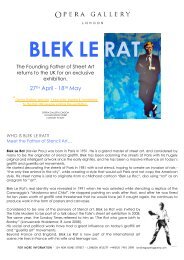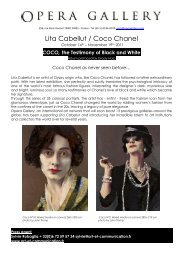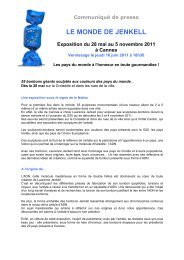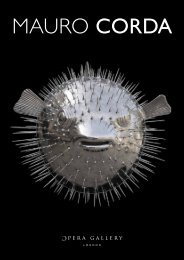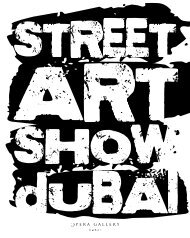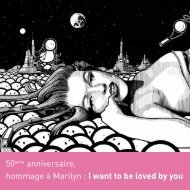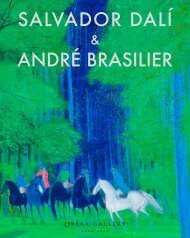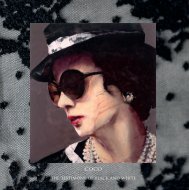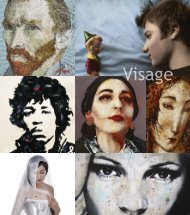Download catalogue - Opera Gallery
Download catalogue - Opera Gallery
Download catalogue - Opera Gallery
Create successful ePaper yourself
Turn your PDF publications into a flip-book with our unique Google optimized e-Paper software.
The logos, the word, the gateway to truth and meaning, it is the sacred geometry of language<br />
and imbued with all the mystical spirituality of the divine. Used principally as a means to<br />
transmit a text, its inherent possibilities of intricate form and aesthetic appeal wove through<br />
underlying talismanic anchors and flourished into myriad ways of exploiting script as ornament.<br />
Denying the thread of consciousness which gave traditional calligraphy its layers of meaning,<br />
another visual landscape is molded out of pure colour where bold letters surge and jostle<br />
against one another in a dichotomy of form and meaning.<br />
Teasing the interplay of decorative elements, one word can give the impression of random<br />
brushstrokes, or a single letter morph into florid knots or floating refrains.<br />
CALLIGRAPHY<br />
is unquestionably<br />
the fundamental<br />
element of Islamic art…<br />
Often illegible or out of context, words free themselves from the strictures of spiritual and poetic<br />
context and become shape for shape’s own sake. In doing so, they make a profound statement<br />
as the art of the word was only ever validated through explicit meaning. Today, a purely visual<br />
movement is replacing the “Written Word” with the “Painted Word” or Naqqashi-khat.<br />
Moving beyond language, the letters are not painted to be understood but to redefine the<br />
ancient roots of their relationship with experience. These singular symbols reject their traditional<br />
reading and redirect the experience to evoke sensations rather than the structural<br />
familiarity of language. Indeed language is actively denied a role in both the expression and<br />
the understanding of the new calligraphy, opening fluid portals to sensory abstraction. Yet<br />
as in the iconography of painting the basic reference points remain intact and meaning is<br />
awoken through re-contextualization. The illusion of infinity running through traditional calligraphy<br />
and the “arabesque” prevails, but legibility is drowned in a sea of form and colour as<br />
seen in the transition between the works of Mohammad Ehsai.<br />
The interwoven letters of Ajali fray into unintelligible heaps of strokes and coils. The floating<br />
letters of Bakhshayeshi rise in isolation and circle through an alchemical abysss as the<br />
intricate incantations of Afjehei merge into a seemingly single stroke of the brush. The<br />
repetitions echo ancient calligraphic exercises but the letters have the majesty of the<br />
spectacular. Theatrical repetition is a fundamental element and yet we also see dramatic<br />
independence as in the work of Mohammad Yaghoubian. In Naqqashi-khat the deliberate<br />
and tranquil contemplation of the unfathomable is quickened through intense colour and<br />
complexity as it drums out a faster, stronger and bolder heartbeat. Yet beneath the loud and<br />
proud odes to modernity whisper the refrains of the timeless, the ancient and the archetypal<br />
as history flowers anew.<br />
Zahra Faridany-Akhavan PhD<br />
6 7



